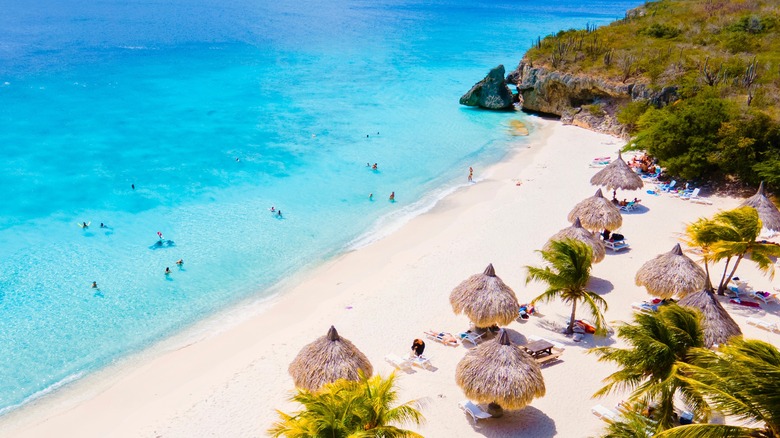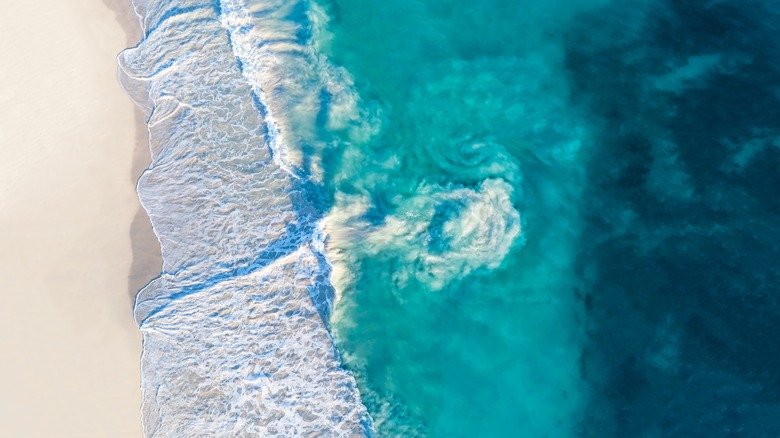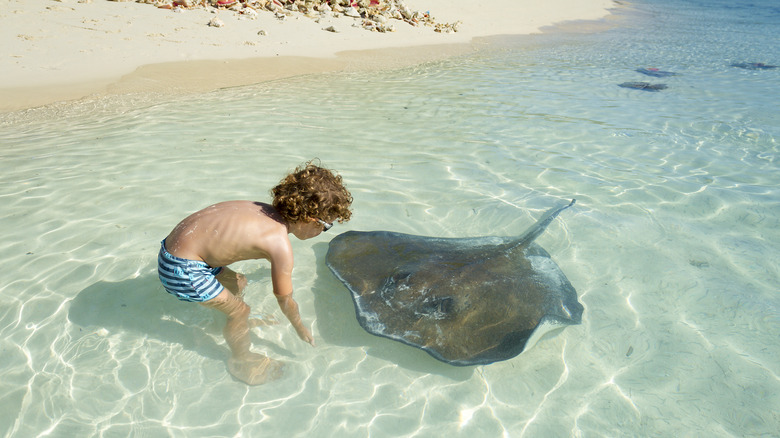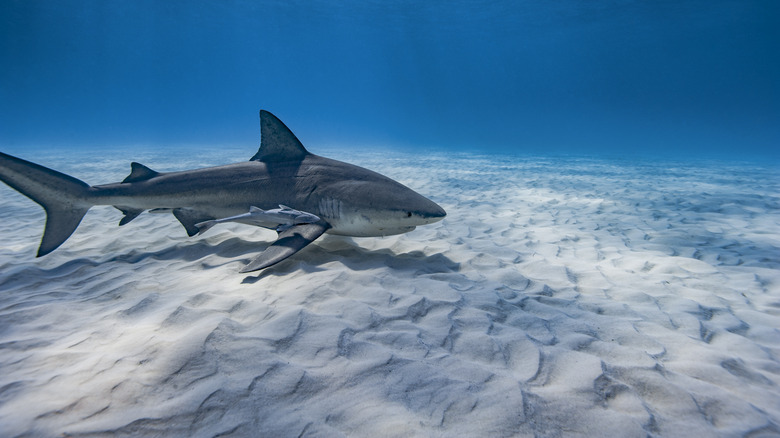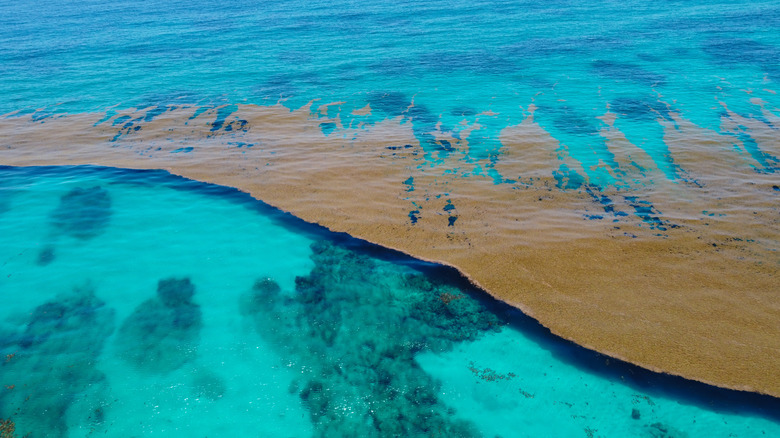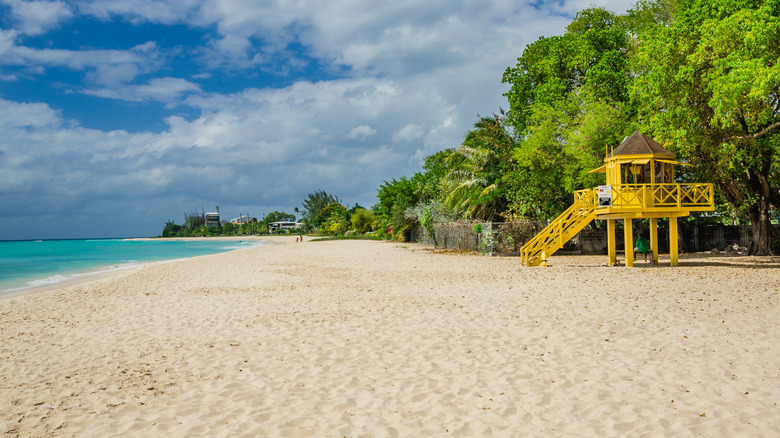The Hidden Dangers Of Swimming In The Caribbean Sea
In 2022, 28.3 million tourists flocked to the Caribbean, as reported by the Caribbean Tourism Organization. Vacationers with a hankering for crystal clear waters and pristine beaches traversed to the region in droves, with six countries outperforming the number of their pre-pandemic visitors, including St. Maarten, Curacao, and the Turks and Caicos.
The appeal of the Caribbean is undeniable, which explains why it's a top choice for millions seeking their fair share of sun-soaked bliss. However, despite its reputation for having diverse marine life and beautiful coastlines, it's essential to know that the region also presents various hidden dangers. This isn't to say that you should knock it off your bucket list, of course.
But if your dream vacation involves swimming in its azure waters, awareness of what could lie within the waves is crucial. From alarmingly strong currents to unexpected marine encounters, here are some of the hidden dangers of swimming in the Caribbean so you can be well-prepared for your time in paradise and have an experience that is just as safe as it is thrilling.
Beware of rip currents
The Caribbean may have some of the most beautiful beaches in the world, but some have potential dangers that aren't always noticeable. The Condado Beach in Puerto Rico, the Maracas and Manzanilla beaches in Trinidad and Tobago, and Rendezvous, Little Bay, and Carr's Bay beaches in Montserrat are known for their strong rip currents, particularly during the hurricane season that runs from June to November.
To the uninitiated, rip currents are currents of water powerful enough to yank you away from land — and fast. The National Weather Service points out that while many rip currents are relatively mild, the worst of them can surpass speeds of 5 mph, even beating the capabilities of Michael Phelps. To non-Olympians like many of us, being caught in such currents can be extremely dangerous and may result in drowning.
It's crucial to understand that rip currents do not pull swimmers underwater, but their strength can sometimes be enough to take you past surf zones. This can be alarming, but experts advise against fighting it. Falk Feddersen, professor of physical oceanography at Scripps Institution of Oceanography, told USA Today that it's best to conserve energy and float with it instead. "Once you're away from the active current, you can swim back to shore," he said. More importantly, heed warning signs and advisories of lifeguards if there are any. If there are alerts about rip currents, consider chilling by the shore instead. It's always better to be safe than sorry.
Stingrays aren't always friendly
In the Caribbean, notably in places like Antigua, Turks and Caicos, and the Cayman Islands, interacting with stingrays is a popular tourist activity. These regions are known for their stingray tours, where visitors are taken to areas with a high concentration of these creatures so they can observe them up close. Then again, stingrays can pose risks, as we've come to learn from the tragic demise of famed wildlife conservationist Steve Irwin.
Though stingray encounters, especially under the supervision of experienced tour guides, are often safe and enjoyable, caution is advised when interacting with them independently. According to the National Ocean Surface, stingrays often linger near the shore, making casual sightings possible. Just be mindful of your actions when you're near one, as their barb attacks can be dangerous. "Stingrays only flick their barbs upwards in an involuntary reflex action if they feel threatened, as a defensive measure when it is caught, stepped on or otherwise disturbed," marine biologist Alan Henningsen told NBC News. If you encounter them when exploring on your own, it's highly suggested to steer clear of swimming above them, or better yet, avoid approaching them altogether to ensure your safety.
It's worth noting, however, that deaths caused by stingrays are rare, with less than 20 incidents recorded globally, according to The Conversation. So, there's no need to panic when you're near one. As long as you're respectful of their space, you can freely admire them from a safe distance.
Be cautious of sharks
There's a common misconception that most sharks are dangerous to humans because of mainstream media (see also: the "Jaws" effect), but the reality is quite the opposite. According to the Florida Museum, only approximately 30 shark species out of more than 500 have been known to attack humans, and the odds of getting attacked by one are remarkably low, only about one in 3.7 million. In fact, you're more likely to die from a rip current than from a shark bite.
Still, this doesn't mean you can let your guard down when swimming in certain areas of the Caribbean, particularly the West End in the Bahamas. It's home to 30 to 40 shark species, including potentially aggressive ones like bull and tiger sharks. In late 2023, Loop News reported two shark attacks in this region, resulting in one fatality and one missing person. "There have been more shark bites on humans than anywhere else in the Caribbean, but that's largely because the Bahamas are a tourist destination," Dr. Gavin Naylor, director of the Florida Program for Shark Research, told WESH2.
When swimming, it's essential to exercise caution. Avoid swimming on your own, and always stay close to the shore. Naylor also recommends avoiding wearing shiny swimwear to avoid being mistaken for fish and steer clear of turbid waters. "Don't worry. Shark attacks are incredibly rare but secondly, be sensible, if you see sharks in the water don't say, 'oh, they're safe,'" he said.
The threat of flesh-eating bacteria
As if killer marine animals aren't enough, there's also the threat of contracting flesh-eating bacteria when swimming in the Caribbean. In January 2023, Jennifer Barlow, a U.S. Army veteran, experienced a harrowing health scare following her trip to the Bahamas. She returned home with a severely swollen knee, warranting an immediate trip to the hospital. "... it was at least three times the size of my left knee. It was really scary," she told Today. "I was in excruciating pain." Her doctors diagnosed her with necrotizing fasciitis, a bacterial infection that the Cleveland Clinic categorizes as a "flesh-eating disease." Regrettably, Barlow's condition had been so severe that amputation of her leg became necessary.
The exact source of her infection remains unclear, but Barlow has reason to believe that she may have gotten it from the Bahamas. Per CNN, Vibrio vulnificus, a flesh-eating infection that can cause necrotizing fasciitis, has been detected in the Caribbean. It was particularly prevalent in sargassum (a type of seaweed) and seawater.
While there is understandable concern, there's no cause for alarm just yet, with marine microbiologist Linda Amaral-Zettler telling NBC News that not every seaweed you encounter poses a lethal threat. "I don't think everyone should be running away from sargassum as if it's going to kill them," she said. "That's simply not the case. But I think we need to think responsibly about the potential risks." Instead, according to the CDC, what you should be careful about is exposing open wounds to seawater and consuming raw seafood.
Limited lifeguard supervision
One more thing to know about beaches in the Caribbean? Not all of them are safe to swim, not because they are teeming with dangerous elements, but because many don't have lifeguards. In 2023, Loop News reported there was a critical shortage of lifeguards at Tyrico Beach in Trinidad and Tobago, a situation that led to drowning incidents. The same thing happened the previous year in Puerto Rico's Flamenco Beach, with CBS News reporting that there's also a lack of lifeguard presence in the area.
The Red Cross strongly advises against swimming at unpatrolled beaches, regardless of one's swimming abilities. The presence of lifeguards is crucial not only for their expertise in rescue operations but also for their knowledge of local water conditions, enabling them to alert swimmers to potential dangers.
And sure, it may be tempting to wade into emerald waters, but it's still not recommended when there are no lifeguards around. This warning applies even in the presence of locals. "We find many Barbadians go to a lot of beaches that don't have lifeguard stations because of tradition and because they know the area. However, we caution beach users that if they do not know the location, because they see persons going there, they should not follow them," Keith Neblett, general manager of the National Conservation Commission in Barbados told Loop News. "Those persons know these areas and they know the pros and cons of them."
